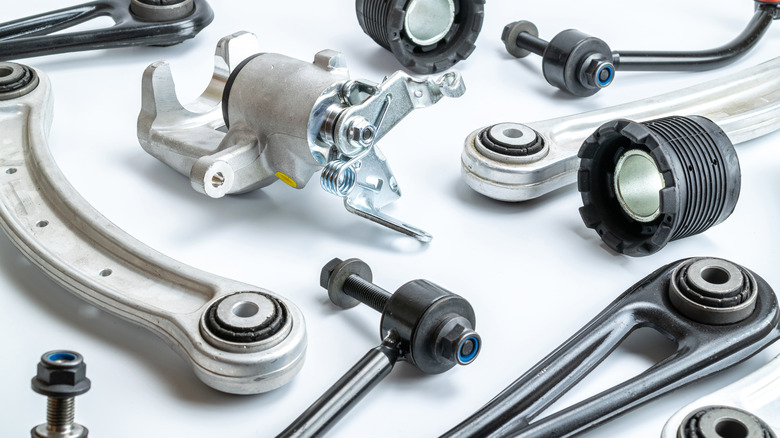What OEM Stands For And What It Means For Your Car
While the auto industry has no shortage of complex jargon, one of the simplest tags to understand is 'OEM.' Short for 'original equipment manufacturer', this oft-used acronym refers to a company that produces goods used in another company's product. More specifically, in the automotive industry, OEM refers to components produced by one manufacturer for another manufacturer's brand — in other words, an OEM part is an authentic replacement part, even though it may not carry the car brand's logo.
Most automakers outsource components to other manufacturers, piecing these parts together on their assembly line. The complexity of the U.S. automotive industry's global supply chain means vehicles are rarely built entirely in-house with U.S. parts. But outsourcing components to outside manufacturers does not imply a reduction in quality: whether it be brake pads, shocks, or bearings, OEM companies are chosen for their expertise in the field, manufacturing components to the automaker's specifications to ensure proper fit and performance.
Nevertheless, many classic car owners demand branded replacement parts for their pride and joy — and indeed some car companies stock genuine parts for models up to 70 years old. But authenticity doesn't always mean highest quality. For daily drivers, a non-genuine, aftermarket part can deliver better performance and durability than its genuine counterpart. Auto brands and consumers know this, which is why Toyota fits Fox shocks and ARB bumpers to its stock, off-the-shelf Tacoma TRD Pro, and why a set of aftermarket wheels is often the first upgrade a new car owner makes.
With the original, you know what you are getting
The need for replacement parts is an inevitable part of ongoing repair and maintenance, with components falling into two categories: OEM or aftermarket. Knowing the pros and cons of each can help you choose the right part for you. An OEM part is built to factory specifications, while an aftermarket part — as its name suggests — is made by a third party. Recycled parts are another option, either OEM or aftermarket — but there are some parts you should never buy used.
Buying OEM makes the choice easy: go straight to the dealership, who will help you find the correct part, eliminating the worry of comparing brands, prices, and quality. Most dealers provide a one-year warranty on parts, too. But such convenience and reassurance comes at a cost, as OEM parts and dealership repairs generally have a higher price tag than aftermarket alternatives.
Economies of scale mean aftermarket parts can be cheaper and more widely available. Walk into any parts store, and you will find a wide range of replacements. However, these generic parts may fit many different vehicles, and lack the snug fit of an OEM part. A lower-quality part may also have a shorter lifespan, or even damage your vehicle. Furthermore, insurers do not always cover aftermarket parts, especially with body shop repairs. On the other hand, a reverse-engineered part can sometimes improve on the original design.
Buyer beware: there are fakes out there
Buying a genuine OEM part directly from a dealership — or even via the OEM website — means you have technical support to help you find the correct part, and customer service backing to replace it should they be unsuitable. Choosing an OEM part doesn't necessarily mean you have to buy directly from the manufacturer or dealer, however, as our detailed guide to buying OEM parts on Amazon explains.
When shopping for car parts, OEM offerings are everywhere, but it pays to check that the marketing promises align with reality. Just like fake brands, OEM claims can be faked: just because a website or an independent mechanic claims a part is OEM, that is no guarantee that it is. A part may look genuine, or carry marketing claims that lead you to think it is from an original manufacturer, but not meet proper standards, and can even be dangerous.
When buying parts, it pays to deal with a reputable supplier. In the 2024 fiscal year, U.S. Customs and Border Protection (CBP) seized more than 211,000 counterfeit auto parts, almost double that in the previous year. In an InvestigateTV report, director for intellectual property and e-commerce at CBP's Office of Trade, Christopher Mabelitini, said buyers should check who the part manufacturer is, and their whereabouts. "You think you're getting a really great deal on whatever that product is, and unbeknownst to you, it's coming from a foreign manufacturer who has counterfeited that product."


